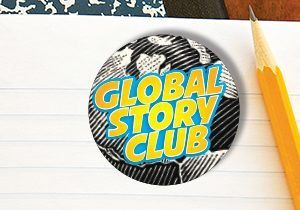
Plan your own film: Primary resource
Practise writing in narratives, creating settings, characters and plot
The primary resources available to download here have been made in partnership with Elstree Film Design.
Learn how to plan, script and storyboard a short film or animation idea. Discover the processes involved in filmmaking, and the kinds of considerations that filmmakers have to take when they plan a new film.
Activity: Follow the two lesson plans to guide children through deciding upon a style and theme for their own film / animation and writing a short script (lesson 1). In lesson 2, children are challenged to transform the ideas from their script into a storyboard and fill out the Planning for production worksheet.
N.B. The following information for mapping the resource documents to the school curriculum is specifically tailored to the English National Curriculum and Scottish Curriculum for Excellence. We are currently working to bring specifically tailored curriculum resource links for our other territories; including South Africa, Australia and New Zealand. If you have any queries about our upcoming curriculum resource links, please email: schools@ngkids.co.uk
This film primary resource assists with teaching the following English objectives from the National Curriculum:
A high-quality education in English will teach pupils to speak and write fluently so that they can communicate their ideas and emotions to others and through their reading and listening, others can communicate with them.
The national curriculum for English aims to ensure that all pupils:
- write clearly, accurately and coherently, adapting their language and style in and for a range of contexts, purposes and audiences
- use discussion in order to learn; they should be able to elaborate and explain clearly their understanding and ideas
- are competent in the arts of speaking and listening, making formal presentations, demonstrating to others and participating in debate
National Curriculum Key Stage 1 English (Year 1) objectives:
Pupils should be taught to: understand both the texts they can already read accurately and fluently and those they listen to by:
- drawing on what they already know or on background information and vocabulary provided by the teacher
- checking that the text makes sense to them as they read and correcting inaccurate reading
- discussing the significance of the title and events
- making inferences on the basis of what is being said and done
- predicting what might happen on the basis of what has been read so far
Pupils should be taught to:
- participate in discussion about what is read to them, taking turns and listening to what others say
- explain clearly their understanding of what is read to them
- write sentences by: sequencing sentences to form short narratives
- discuss what they have written with the teacher or other pupils
- read aloud their writing clearly enough to be heard by their peers and the teacher
National Curriculum Key Stage 1 English (Year 2) objectives:
Pupils should be taught to: develop positive attitudes towards and stamina for writing by:
- writing narratives about personal experiences and those of others (real and fictional)
- writing for different purposes
Pupils should be taught to: consider what they are going to write before beginning by:
- planning or saying out loud what they are going to write about
- writing down ideas and/or key words, including new vocabulary
- encapsulating what they want to say, sentence by sentence
Pupils should be taught to: make simple additions, revisions and corrections to their own writing by:
- evaluating their writing with the teacher and other pupils
- re-reading to check that their writing makes sense and that verbs to indicate time are used correctly and consistently, including verbs in the continuous form
Pupils should be taught to: read aloud what they have written with appropriate intonation to make the meaning clear
National Curriculum Key Stage 2 English (Year 3 and 4) objectives:
Pupils should be taught to:
- develop positive attitudes to reading and understanding of what they read by: preparing poems and play scripts to read aloud and to perform, showing understanding through intonation, tone, volume and action
- draw inferences such as inferring characters’ feelings, thoughts and motives from their actions, and justifying inferences with evidence
Pupils should be taught to: plan their writing by:
- discussing writing similar to that which they are planning to write in order to understand and learn from its structure, vocabulary and grammar
- discussing and recording ideas
Pupils should be taught to: draft and write by:
- composing and rehearsing sentences orally (including dialogue), progressively building a varied and rich vocabulary and an increasing range of sentence structures (English Appendix 2)
- organising paragraphs around a theme
- in narratives, creating settings, characters and plot
- read aloud their own writing, to a group or the whole class, using appropriate intonation and controlling the tone and volume so that the meaning is clear
National Curriculum Key Stage 2 English (Year 5 and 6) objectives:
Pupils should be taught to: maintain positive attitudes to reading and understanding of what they read by: identifying and discussing themes and conventions in and across a wide range of writing
Pupils should be taught to: plan their writing by:
- identifying the audience for and purpose of the writing, selecting the appropriate form and using other similar writing as models for their own
- noting and developing initial ideas, drawing on reading and research where necessary
- in writing narratives, considering how authors have developed characters and settings in what pupils have read, listened to or seen performed
Pupils should be taught to: perform their own compositions, using appropriate intonation, volume, and movement so that meaning is clear
This Film primary resource assists with teaching the following Expressive arts First level objectives from the Scottish Curriculum for Excellence:
- I have the opportunity to choose and explore a range of media and technologies to create images and objects, discovering their effects and suitability for specific tasks.
Scottish Curriculum for Excellence First level Expressive arts objectives:
- I have the opportunity to choose and explore an extended range of media and technologies to create images and objects, comparing and combining them for specific tasks.
Scottish Curriculum for Excellence Second level Expressive arts objectives:
- I can create and present work that shows developing skill in using the visual elements and concepts.
Scottish Curriculum for Excellence Third level Expressive arts objectives:
- I can use and combine the visual elements and concepts to convey ideas, thoughts and feelings in expressive and design work.
Scottish Curriculum for Excellence Fourth level Expressive arts objectives:
- I can use the visual elements and concepts with sensitivity to express qualities and relationships and convey information, thoughts and feelings. I can use my skills and creativity to generate original ideas in my expressive and design work.
Download primary resource
More Like

Global Story Club: The Dragon

Jamala Wildlife Lodge

Global Story Club: Pizza









LEAVE A COMMENT
THANK YOU
Your comment will be checked and approved shortly.
WELL DONE,
YOUR COMMENT
HAS BEEN ADDED!
COMMENTS
CUSTOMIZE YOUR AVATAR